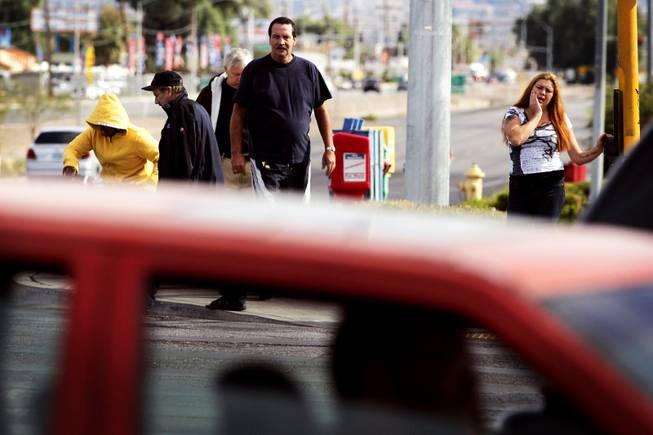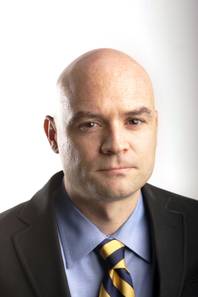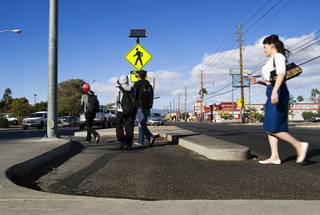
Pedestrians wait to cross the street at the busy intersection of Boulder Highway and Tropicana Avenue in Las Vegas Thursday, November 3, 2011.
Tuesday, Nov. 8, 2011 | 2 a.m.

J. Patrick Coolican
Interactive map
Pedestrian killed near Alta
KSNV coverage of pedestrian being hit and killed in Las Vegas, Nov. 5, 2011.
Sun Archives
- LV Becoming Paradise For Many Jaywalkers (4-15-1979)
- Pedestrian fatalities climbing (5-1-1988)
- LV pedestrian deaths linked to tourists (8-30-1992)
We do not notice them, but we should. Pedestrians are our city’s second-class citizens, as has become all too clear with the recent spate of deadly incidents.
And while rage at the drivers may make us feel better, we should also have a feeling of collective guilt, for these deaths are merely the most extreme and tragic result of what is a colossal public policy failure.
How so?
During the 1990s, cities across the country embraced what’s called New Urbanism, a central plank of which is walkable communities.
Why? Well, we’ve finally discovered that aside from sustenance and procreation, there are two things that all humans need: physical activity and social interaction. I discourage you from testing my assertion, because if you try to live without these two essentials, first you will go crazy, then you will acquire chronic diseases and then you will die an unpleasant death.
Some genius figured out that walking in an urban environment achieves both of these necessary activities at the same time, and also people like it. (Among Generation Y, 80 percent said they’d like to live in an urban environment, or if in a suburb one that offers walkability, according to polling from real estate consulting firm RCLCO.)
Given the rapid growth of Las Vegas during the ’90s, right when New Urbanism was sweeping the country, you would think we’d have built a utopia of walkability and livability.
You would think. But no, not us. That was for hippies.
We handed the keys of the city to developers, who did what they knew how to do from making boatloads of money in Southern California — auto-dominated suburbia. So we have a city for cars, not people. (Let’s except the Strip, which is generally safe and stimulating for walkers. We treat the customers better than we treat the help.)
As we’ve learned, though they may seem invisible, we have far more pedestrians than we think.
I went to Boulder Highway and Tropicana Avenue to talk to pedestrians, and they had horror stories: Nightmare intersections, broken signals, near misses. A woman who asked to be called Kat drives a motorized wheelchair and says she was backed over in a Walgreens parking lot by a drunken motorist.
Harold Archuleta was making his way up Boulder Highway. “It is dangerous,” he says.
According to the pedestrian advocacy group Transportation for America, Las Vegas is the sixth-most-dangerous city in the country for walkers.
When Archuleta complained to a Metro Police officer that the pedestrian signal at Indios Avenue wasn’t working, the officer helpfully told him to go to the other side of the street. Implicit there is the subtle contempt that many people here feel for pedestrians — if you don’t have a car, clearly there’s something wrong with you, so you don’t deserve my respect. (A colleague who frequently walks in his neighborhood says ruefully that drivers seem to think Las Vegas is some sort of bizzaro world where cars always have the right of way.)
So what can be done? Unfortunately, to some extent, there’s not much we can do. We made this mess — what James Howard Kunstler, author of “Geography of Nowhere,” calls “Drive-in World” — and now we’re stuck with it.
But there are a few steps we can take, at fairly minimal cost, that would make life safer and less stressful for pedestrians. That in turn might encourage more people to take to the streets, which would make walking even safer because with a critical mass of pedestrians, drivers would pay more attention to them.
Kelly Morphy of the Walkable and Livable Communities Institute offers these tips:
• Where we think people might be walking, reduce speed limits. Duh. People hit by cars approaching 40 mph die 85 percent of the time, while at 20 mph they die only 5 percent of the time.
• Many people don’t drive the speed limit. They drive what they perceive to be a safe speed. So, people drive faster on wider roads. Guess what? Oops, we built really wide roads. And, we have narrow sidewalks — in neighborhoods lucky enough to have them — that are bordered by enough imposing walls for a citywide Pink Floyd concert. Sidewalks should be widened, and driving lanes narrowed.
• Create buffers between the sidewalk and the road. I recommend desert landscaping. This serves a second purpose: It makes walking more interesting: As Kunstler says, “If the journey is unrewarding, people will not walk, and walking past walls and parking lots and the aprons of strip malls is extremely unrewarding.” But if we don’t want to spend the money, then street parking will serve the same purpose.
• Alter intersections to make them tighter and to necessitate tighter turns. This forces drivers to slow down.
• Better crosswalk markings, especially if they’re in the middle of a block.
• Consider roundabouts. Drivers hate them, but they compel them to slow down and eliminate deadly left-hand turns.
• Once we need to replace streets, consider brick for residential neighborhoods. It also slows down drivers.
And finally, here’s an idea: People who get lots of moving violations should be forced to be crossing guards for a week.



Join the Discussion:
Check this out for a full explanation of our conversion to the LiveFyre commenting system and instructions on how to sign up for an account.
Full comments policy